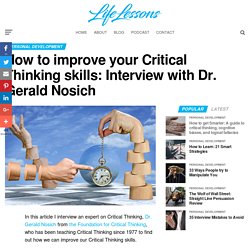

Radical Listening to Improve Understanding of System Dynamics. Style Journal Article Reporting Standards (APA Style JARS) We have published a revised version of our Privacy Statement.

Please read these updated terms and take some time to understand them. Learn more Got it skip to main content Highlights Supplemental Resource on the Ethic of Transparency in JARS APA Style JARS Supplemental Glossary Guidelines Quantitative Research Use JARS–Quant when you collect your study data in numerical form or report them through statistical analyses. Qualitative Research Use JARS–Qual when you collect your study data in the form of natural language and expression. Mixed Methods Research Use JARS–Mixed when your study combines both quantitative and qualitative methods. Active Listening. How to be a great listener. 28 Critical Thinking Question Stems For Any Content Area - 28 Critical Thinking Question Stems For Any Content Area.

6 Questions Every Critical Thinker Should Ask. Divergent Thinking Video.wmv. To Boost Higher-Order Thinking, Try Curation. How to improve your Critical Thinking skills: Interview with Dr. Gerald Nosich – Life Lessons. In this article I interview an expert on Critical Thinking, Dr.

Gerald Nosich from the Foundation for Critical Thinking, who has been teaching Critical Thinking since 1977 to find out how we can improve our Critical Thinking skills. In this article you will learn: Let’s start at the beginning… Writing a Critique. A critique (or critical review) is not to be mistaken for a literature review. A 'critical review', or 'critique', is a complete type of text (or genre), discussing one particular article or book in detail. In some instances, you may be asked to write a critique of two or three articles (e.g. a comparative critical review). In contrast, a 'literature review', which also needs to be 'critical', is a part of a larger type of text, such as a chapter of your dissertation. Most importantly: Read your article / book as many times as possible, as this will make the critical review much easier. Contents 1. Read and Take Notes. The Thinker Builder: Step In, Step Out: A Strategy for Thinking Deeply About Text.
You're sitting at your guided reading table, your little group gathered around you, wide-eyed.

Or are you the one who's wide-eyed? Sure, you know what you're doing, but maybe right now you're thinking your lesson plan doesn't fit the book like you thought it would. Studying for exams? Here's how to make your memory work for you. Have you ever thought about how your brain works when you study?

Knowing this may improve your ability to retain and recall information. There are three main memory structures: sensory, working and long-term memory. Using these tips, you can activate all three to enhance how you study. 1. Try to learn the same content in different ways Activating your sensory memory is the first step. How to write better essays: 'nobody does introductions properly'. As the government begins its crackdown on essay mill websites, it’s easy to see just how much pressure students are under to get top grades for their coursework these days.

But writing a high-scoring paper doesn’t need to be complicated. We spoke to experts to get some simple techniques that will raise your writing game. Tim Squirrell is a PhD student at the University of Edinburgh, and is teaching for the first time this year. The Most Common Verbs Used In Academic Writing – Interpersonal modalities. Empathy in Leadership: Coaching Leaders to Manage Their Stories. When leaders struggle with staff morale or direct reports failing to thrive, a lack of empathy is the lead domino.

These leaders forget that, as humans, we tend to make decisions based on our stories about other people. These stories impact our every interaction with others because we can’t hide the emotions behind them. Our stories also determine our broader management tactics, which can be as wildly off the mark as our stories themselves. Negative stories about others that we hold as leaders come from what Heath and Heath call the “Fundamental Attribution Error” (Switch, 2010).
7 Smart Reasons You Should Talk Less and Listen More. How to paraphrase effortlessly so you can gain clarity from every conversation! Conflictbooklet. Jim Collins - What is the Hedgehog Concept? ArtOfMoney Jim Collins Hedgehog Concept. Good to Great: The Hedgehog Concept. In continuing with the current theme of Good to Great, I would now like to explore the idea that Jim Collin's put forth which he dubbed the Hedgehog Concept.

What Is The Hedgehog Concept? The Hedgehog Concept comes for the old Greek parable about a hedgehog and a fox which states the following: The fox knows many things, but the hedgehog knows one big thing In the story, the fox tries all the possible tricks he knows in order to try catch the hedgehog. He plays dead, chases it, sneaks up on it etc. but every time he fails. Hedgehog Concept by Jim Collins: a Powerful Strategy Tool. This article describes the concept of the Hedgehog Concept by Jim Collins in a practical way.

After reading you will understand the definition and basics of this powerful strategy tool. What is the Hedgehog Concept? The Hedgehog Concept by the American business consultant Jim Collins shows how a company or person can be successful in business. It’s about the power of simplicity, increasing the chance of success. In his 2001 book ‘Good to Great‘, Collins describes the similarities between large organisations like multinational corporations and the Hedgehog Concept. Classic story. Only One in 10 People Possess the Talent to Manage. Story Highlights Talent is the natural capacity for excellenceManagers with high talent are better brand ambassadorsManagers with high talent are more likely to focus on strengths One of the most important decisions companies make is simply whom they name manager, Gallup has found.

Yet our analytics suggest they usually get it wrong: Companies fail to choose the candidate with the right talent for the job 82% of the time. How Humble Leadership Really Works. Executive Summary Top-down leadership is outdated and counterproductive. By focusing too much on control and end goals, and not enough on their people, leaders are making it more difficult to achieve their own desired outcomes. The key, then, is to help people feel purposeful, motivated, and energized so they can bring their best selves to work. One of the best ways is to adopt the humble mind-set of a servant leader.
Servant leaders view their key role as serving employees as they explore and grow, providing tangible and emotional support as they do so. Making time management the organization’s priority. When a critical strategic initiative at a major multinational stalled recently, company leaders targeted a talented, up-and-coming executive to take over the project. There was just one problem: she was already working 18-hour days, five days a week. When the leaders put this to the CEO, he matter-of-factly remarked that by his count she still had “30 more hours Monday to Friday, plus 48 more on the weekend.”
Extreme as this case may seem, the perennial time-scarcity problem that underlies it has become more acute in recent years. The impact of always-on communications, the growing complexity of global organizations, and the pressures imposed by profound economic uncertainty have all added to a feeling among executives that there are simply not enough hours in the day to get things done. Fortunately, this also means that the problem can be tackled systematically. Listening takes more effort than we might think. Here's how to do it well. By Gary Nunn Updated about an hour agoThu 6 Dec 2018, 10:25pm When I contacted people whose job it is to listen — psychotherapists, counsellors, journalists — one thing came up repeatedly.
It was a quote from the late author Stephen Covey: "Most people do not listen with the intent to understand. Amy Cuddy: Your body language shapes who you are. The surprising secret to speaking with confidence [ TEDx : Caroline Goyder ] Top tips for newly qualified social workers. 5 Ways To Ace Your Social Work Job Interview - SocialWorker.com. By Valerie Arendt, MSW, MPP. What makes a TED Talk go viral? These 5 nonverbal patterns may explain. Hand gestures might make a talk feel more compelling.